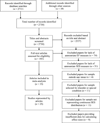A meta-analysis of the relationship between socioeconomic status and executive function performance among children
- PMID: 28557154
- PMCID: PMC5821589
- DOI: 10.1111/desc.12529
A meta-analysis of the relationship between socioeconomic status and executive function performance among children
Abstract
The relationship between childhood socioeconomic status (SES) and executive function (EF) has recently attracted attention within psychology, following reports of substantial SES disparities in children's EF. Adding to the importance of this relationship, EF has been proposed as a mediator of socioeconomic disparities in lifelong achievement and health. However, evidence about the relationship between childhood SES and EF is mixed, and there has been no systematic attempt to evaluate this relationship across studies. This meta-analysis systematically reviewed the literature for studies in which samples of children varying in SES were evaluated on EF, including studies with and without primary hypotheses about SES. The analysis included 8760 children between the ages of 2 and 18 gathered from 25 independent samples. Analyses showed a small but statistically significant correlation between SES and EF across all studies (rrandom = .16, 95% CI [.12, .21]) without correcting for attenuation owing to range restriction or measurement unreliability. Substantial heterogeneity was observed among studies, and a number of factors, including the amount of SES variability in the sample and the number of EF measures used, emerged as moderators. Using only the 15 studies with meaningful SES variability in the sample, the average correlation between SES and EF was small-to-medium in size (rrandom = .22, 95% CI [.17, .27]). Using only the six studies with multiple measures of EF, the relationship was medium in size (rrandom = .28, 95% CI [.18, .37]). In sum, this meta-analysis supports the presence of SES disparities in EF and suggests that they are between small and medium in size, depending on the methods used to measure them.
© 2017 John Wiley & Sons Ltd.
Figures





Similar articles
-
Socioeconomic status and executive function: developmental trajectories and mediation.Dev Sci. 2015 Sep;18(5):686-702. doi: 10.1111/desc.12246. Epub 2015 Feb 9. Dev Sci. 2015. PMID: 25659838
-
Socioeconomic status, white matter, and executive function in children.Brain Behav. 2016 Aug 2;6(10):e00531. doi: 10.1002/brb3.531. eCollection 2016 Oct. Brain Behav. 2016. PMID: 27781144 Free PMC article.
-
Language development as a mechanism linking socioeconomic status to executive functioning development in preschool.Dev Sci. 2022 Sep;25(5):e13227. doi: 10.1111/desc.13227. Epub 2022 Jan 10. Dev Sci. 2022. PMID: 34981872 Free PMC article.
-
Socioeconomic Status and Childhood Executive Function: Differing Conceptualizations, Diverse Assessments, and Decontextualized Investigations.Integr Psychol Behav Sci. 2024 Dec;58(4):1284-1299. doi: 10.1007/s12124-022-09680-w. Epub 2022 Mar 8. Integr Psychol Behav Sci. 2024. PMID: 35260946 Review.
-
The role of the visual association cortex in scaffolding prefrontal cortex development: A novel mechanism linking socioeconomic status and executive function.Dev Cogn Neurosci. 2019 Oct;39:100699. doi: 10.1016/j.dcn.2019.100699. Epub 2019 Aug 8. Dev Cogn Neurosci. 2019. PMID: 31446376 Free PMC article. Review.
Cited by
-
Prefrontal cortical thickness mediates the association between cortisol reactivity and executive function in childhood.Neuropsychologia. 2020 Nov;148:107636. doi: 10.1016/j.neuropsychologia.2020.107636. Epub 2020 Oct 9. Neuropsychologia. 2020. PMID: 33045229 Free PMC article.
-
Responding to joint attention as a developmental catalyst: Longitudinal associations with language and social responsiveness.Infancy. 2023 Mar;28(2):339-366. doi: 10.1111/infa.12515. Epub 2022 Nov 20. Infancy. 2023. PMID: 36404295 Free PMC article.
-
The structure of cognition in 9 and 10 year-old children and associations with problem behaviors: Findings from the ABCD study's baseline neurocognitive battery.Dev Cogn Neurosci. 2019 Apr;36:100606. doi: 10.1016/j.dcn.2018.12.004. Epub 2018 Dec 13. Dev Cogn Neurosci. 2019. PMID: 30595399 Free PMC article.
-
Cross-sectional and longitudinal associations of family income-to-needs ratio with cortical and subcortical brain volume in adolescent boys and girls.Dev Cogn Neurosci. 2020 Aug;44:100796. doi: 10.1016/j.dcn.2020.100796. Epub 2020 May 18. Dev Cogn Neurosci. 2020. PMID: 32479375 Free PMC article.
-
Exploring the Relationship between Cardiorespiratory Fitness and Executive Functioning in Adults with ADHD.Brain Sci. 2023 Apr 17;13(4):673. doi: 10.3390/brainsci13040673. Brain Sci. 2023. PMID: 37190638 Free PMC article.
References
-
- Adler NE, Boyce T, Chesney MA, Cohen S, Folkman S, Kahn RL, Syme SL. Socioeconomic status and health: The challenge of the gradient. American Psychologist. 1994;49(1):15–24. - PubMed
-
- Alexander RA, Scozzaro MJ, Borodkin LJ. Statistical and empricial examination of the chi-square test for homogeneity of correlations in meta-analysis. Psychological Bulletin. 1989;106:329–331.
-
- Bernier A, Carlson SM, Deschênes M, Matte-Gangé C. Social factors in the development of early executive functioning: a closer look at the caregiving environment. Developmental Science. 2012;15:12–14. - PubMed
-
- Berry D, Blair C, Willoughby M, Granger D The Family Life Project Key Investigators. Salivary alpha-amylase and cortisol in infancy and toddlerhood: Direct and indirect relations with executive functioning and academic ability in childhood. Psychoneuroendocrinology. 2012;37:1700–1711. - PubMed
Publication types
MeSH terms
Grants and funding
LinkOut - more resources
Full Text Sources
Other Literature Sources

